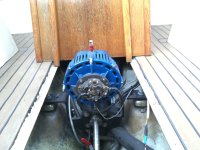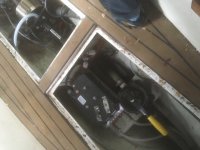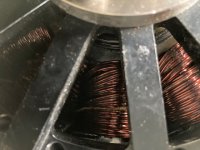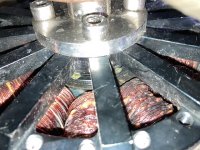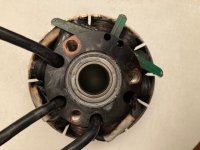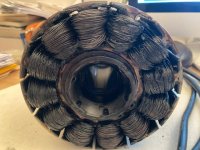Hello,
Since I upgraded my boat to brushless I added acoustic noise & vibrations to my thermal issues.
I am obviously disappointed since the cost (about 2000€) and all my efforts in this migration.
I hope to find here some expertise to help me understand my mistakes and options.
My 6m displacement boat is parallel hybrid, with a 13hp Volvo Penta 2002 diesel and an electric motor on a 10kWh 53V LiFeYPO4 pack on the same shaft (25 mm, 2m, bronze propeller).
I can use the Volvo or the electric, and charge the pack with the Volvo (regen).
Peak power is 1000 rpm, approx 90 N.m. Cruise is around 600-800 rpm, 2 to 5kW.
My previous setup was a brushed Perm PMG 132 with a belt transmission to the shaft (a Bellman product, quite well designed).
It was inaudible, i could only hear the water… a pure pleasure !
But I had power limitations (due to the belt) and cooling issues. And the belt pylon was taking a lot of space.
The motor eventually died from overheating.
I decided to replace it with a compact water-cooled solution :
- Kelly KLS-72701-8080H sinuziodal controller on a big cool plate.
- Revolt RV-160E kv26 with water-cooling, directly on the shaft between the Volvo and the propeller.
- 17l/min @ 24V Flojet water pump from the river (14 to 25°C) through a filter, targeted to use at 12V (quieter).
I am very happy with the power performance and size, but I have 2 major issues : noise and thermal.
1) the motor is noisy
Even if i turn it by hand, i can feel and hear the cogging resonating on the shaft and boat hull, despite the silent-blocks.
I though cogging was a problem at low speed but i feel that noise amplifies with speed. When cruising serval hours it ruins my pleasure.
I am now hesitating to replace the 6 mm 10x10cm aluminium plate that hold the motor stator to its mount with a 15mm rubber plate. I have done no calculation, not sure it will hold the torque, and not sure it will absorbe the vibrations anyway, because they are also transmitted to the shaft.
I was not familiar with the cogging before. I now read it is a tradeoff with efficiency, noise, size…
I imagine it is not as crucial for a bike with other noises (tire/street) and shorter trips.
If I have to replace the motor to get a silent cruise, how to be sure there will be less cogging, ie for example does Golden Motor have less cogging than Revolt ?
Unless I go for a slotless motor, which does not seem available for those rpm & torque.
2) despite water-cooling the motor gets way too hot
For example :
- at 2000W the motor's temperature stabilises at 80°C after 30 minutes.
- at 5000W (100A) it goes > 130°C in 12 minutes (while the controller stays < 30°C).
As Revolt told me, it is possible I am not using the motor on its optimum working point : the perfect matching would have been kv22 or kv24 instead of kv26. Still it is far from expected : RV160E is marketed for continuous operations at 150°C, 15kW continuous power.
Last, the efficiency might be bad : my BMS displays a current on the battery pack about 30% superior of motor current from the controller.
Revolt confirms those temperature are not normal, and tells me to adjust the timing in the controller. I am not sure we can do that in the Kelly KLS. do you think i should get the « Timing Adjustment Tool » ?
Sorry it was long, i wanted to give you enough details.
Thank you so much for your ideas,
Arnaud
Since I upgraded my boat to brushless I added acoustic noise & vibrations to my thermal issues.
I am obviously disappointed since the cost (about 2000€) and all my efforts in this migration.
I hope to find here some expertise to help me understand my mistakes and options.
My 6m displacement boat is parallel hybrid, with a 13hp Volvo Penta 2002 diesel and an electric motor on a 10kWh 53V LiFeYPO4 pack on the same shaft (25 mm, 2m, bronze propeller).
I can use the Volvo or the electric, and charge the pack with the Volvo (regen).
Peak power is 1000 rpm, approx 90 N.m. Cruise is around 600-800 rpm, 2 to 5kW.
My previous setup was a brushed Perm PMG 132 with a belt transmission to the shaft (a Bellman product, quite well designed).
It was inaudible, i could only hear the water… a pure pleasure !
But I had power limitations (due to the belt) and cooling issues. And the belt pylon was taking a lot of space.
The motor eventually died from overheating.
I decided to replace it with a compact water-cooled solution :
- Kelly KLS-72701-8080H sinuziodal controller on a big cool plate.
- Revolt RV-160E kv26 with water-cooling, directly on the shaft between the Volvo and the propeller.
- 17l/min @ 24V Flojet water pump from the river (14 to 25°C) through a filter, targeted to use at 12V (quieter).
I am very happy with the power performance and size, but I have 2 major issues : noise and thermal.
1) the motor is noisy
Even if i turn it by hand, i can feel and hear the cogging resonating on the shaft and boat hull, despite the silent-blocks.
I though cogging was a problem at low speed but i feel that noise amplifies with speed. When cruising serval hours it ruins my pleasure.
I am now hesitating to replace the 6 mm 10x10cm aluminium plate that hold the motor stator to its mount with a 15mm rubber plate. I have done no calculation, not sure it will hold the torque, and not sure it will absorbe the vibrations anyway, because they are also transmitted to the shaft.
I was not familiar with the cogging before. I now read it is a tradeoff with efficiency, noise, size…
I imagine it is not as crucial for a bike with other noises (tire/street) and shorter trips.
If I have to replace the motor to get a silent cruise, how to be sure there will be less cogging, ie for example does Golden Motor have less cogging than Revolt ?
Unless I go for a slotless motor, which does not seem available for those rpm & torque.
2) despite water-cooling the motor gets way too hot
For example :
- at 2000W the motor's temperature stabilises at 80°C after 30 minutes.
- at 5000W (100A) it goes > 130°C in 12 minutes (while the controller stays < 30°C).
As Revolt told me, it is possible I am not using the motor on its optimum working point : the perfect matching would have been kv22 or kv24 instead of kv26. Still it is far from expected : RV160E is marketed for continuous operations at 150°C, 15kW continuous power.
Last, the efficiency might be bad : my BMS displays a current on the battery pack about 30% superior of motor current from the controller.
Revolt confirms those temperature are not normal, and tells me to adjust the timing in the controller. I am not sure we can do that in the Kelly KLS. do you think i should get the « Timing Adjustment Tool » ?
Sorry it was long, i wanted to give you enough details.
Thank you so much for your ideas,
Arnaud


